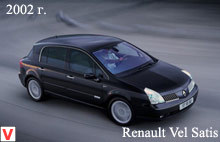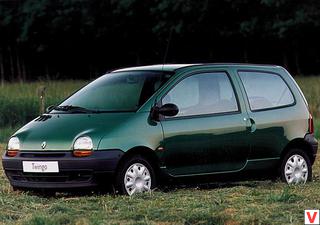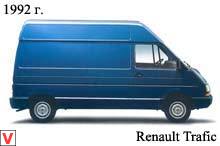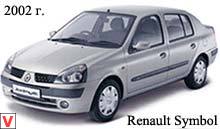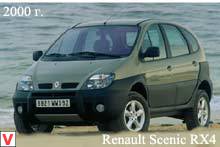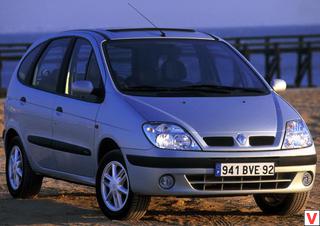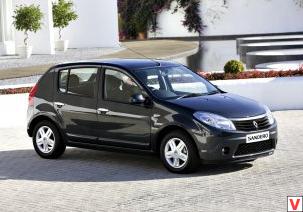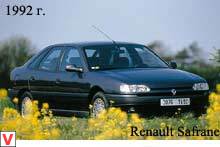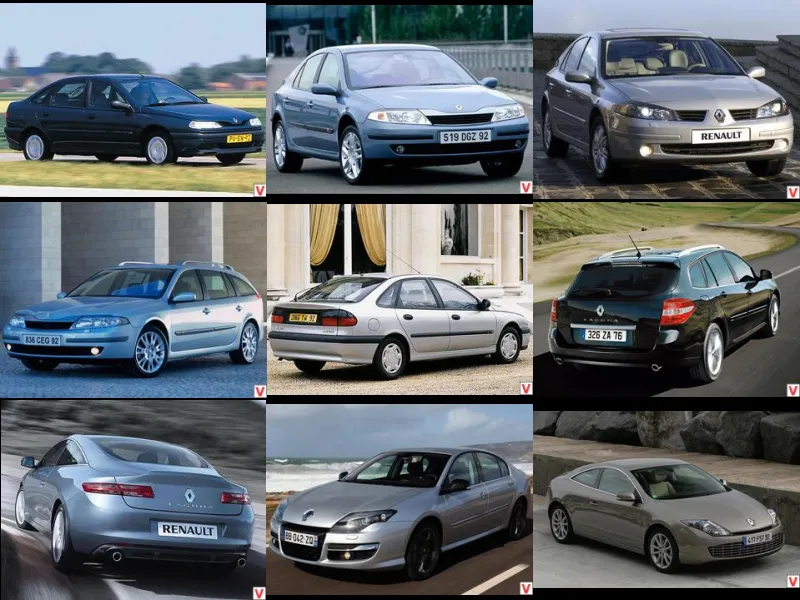
In 1994, Renault introduced the Laguna, a middle-class car with a transverse engine and front-wheel drive. The first generation received a galvanized body and reliably protected from corrosion. The interior deserves special attention. Comfortable spacious lounge, the decoration of which used expensive quality materials. Solid dashboard and soft comfortable seats. Traditionally high level of safety for French cars: programmed crumple zones, hard power frame and bars in the door. Wide racks help with collisions, although they limit visibility.
Until 1995, the Renault Laguna was produced only in the back of a five-door hatchback. After an alternative appeared in the form of a station wagon. Laguna Nevada is a harmonious blend of sedan elegance and station wagon roominess. The car offers seven seats for a large family or a five-seat version with a spacious luggage compartment. By folding the rear seat backs, you can increase the amount of luggage up to 1782 dm³. Plus, the interior of the car provides four options for modeling the cabin. The line of power units of the first generation Laguna consists of: 1.8 liter gasoline engines (95/90 hp), 2.0 l / 115 hp, 3.0 l.

V6 / 170 hp and a 2.2-liter diesel power 85 hp Engines Renault Laguna combine power and efficiency. Since 1995, the standard package includes an anti-blocking scheme and two airbags. Many versions have air conditioning. In 1997, the lineup was supplemented with a 24-valve petrol engine V6 of 2.9 liters capacity of 190 hp. The model of the first generation proved to be quite good: elegant design, functionality, a large selection of different equipment options.
In 1998, the Renault Laguna has undergone an easy upgrade. Updated model design, new engines. In 1999, a version with a 1.6-liter 16-valve engine and 107 hp was released, as well as a variant with a new diesel engine with direct injection with a capacity of 98 hp. In 2000, debuted the second generation Renault Laguna. Compared with its predecessor, the sedan and wagon are several centimeters longer: the hatchback is 4.58 m, and the wagon is 4.7 meters.
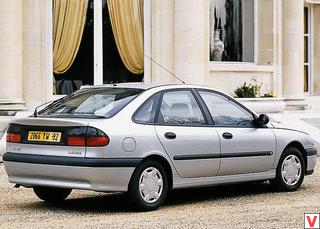
In addition to the stylistic turn in the company's policy, in designing the Laguna II, great attention was paid to the technical and technological excellence of the model. Laguna II Break, conservative in its purpose, has received an even more progressive design complemented by original and relevant cabin ergonomics. On the car there is no ignition key in the usual form. His role is played by a plastic card, which is swallowed by a slot in the front console. The engine is started and stopped by pressing the “start / stop” button.
The air conditioner has separate controls for the driver and passenger, cruise control is provided (standard on versions with automatic), a device that helps with parking, a navigation system with GPS. Laguna can also be fitted with mounts for bikes and LCD monitors for rear passengers, built into the headrests of the front seats and connected to the DVD player. Active safety is provided by the standard ABS, PBS, dynamic stabilization system, emergency brake assist and even a tire pressure monitoring device.
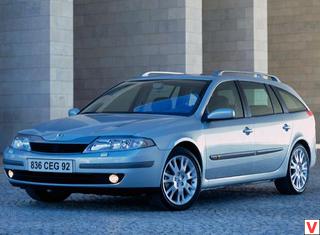
The programmable active safety system includes new adaptable airbags and belts with a tension limiter and two pretensioners - one is triggered at a speed of less than 65 km / h (to reduce the load on a person unnecessarily), the second is at a higher one. The seat belts are installed in both the front and rear seats. In total, the car of any configuration has at least eight airbags. The range of power units is quite extensive. Of the gasoline engines are 1.6 l / 110 hp, 1.8 l / 120 hp. and V6 3.0 l / 210 hp All have four valves per cylinder.
A little later, a two-liter engine with direct injection of gasoline IDE, which meets the Euro 4 standards, was equipped with a variable valve timing system. The range of diesel engines consists of two 1.9-liter engines, developing 105 and 110 hp. Later they were joined by a 1.9-liter dCi with a common-rail system, which develops 120 hp.
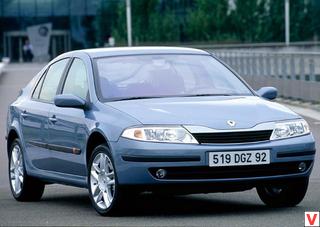
and a torque of 270 Nm thanks to a variable-geometry turbocharger and a 2.2-liter dCi power unit delivering 135 hp. Subsequently, with the 1.6-, 1.8- and 2.0-liter petrol “fours” and 1.9-liter diesel engines, 4-speed “Proactive” transmissions were installed - an “automatic” that adapts to the driving mode and manner driver's controls. It has already been used on other Renault models, but here it is supplemented with the ability to shift gears manually. A new, five-band transmission, also adaptive, is placed only on “Laguna” with a V6 and with a 135-strong dCi.
A new 6-speed "mechanics" is aggregated with the two most frisky diesel engines, 120 and 135 hp. Of course, offered and the usual manual. The main difference between the Laguna II and the previous one is the use of a semi-dependent suspension with a torsion beam at the rear instead of an independent one. But the new suspension is much lighter and provides, in general, not the worst characteristics. The rest of the second generation Renault Laguna retained the ascetic features of its predecessor. In 2005, Laguna underwent a light facelift procedure. The main difference between the updated model is the design of the front end.
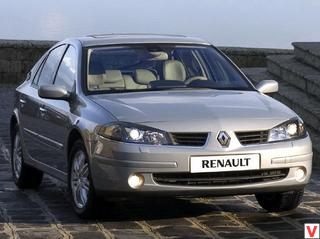
There are new headlights, a new grille, a new front bumper and a hood. The dashboard has also changed, the list of basic equipment has expanded. The line of engines as a whole remained unchanged. Only the two-liter gasoline turbo engine became more powerful: 200 instead of 163 horsepower, and also new 4 and 6-cylinder diesel engines appeared. The lineup of new diesel engines includes power units with 105, 120, 140 and 170 horsepower.
The updated version was supposed to support consumer demand before the release of the third generation Laguna. The official premiere of the third generation took place at the Frankfurt Motor Show in 2007. It should be noted that, unlike previous generations, the wagon appeared simultaneously with the hatchback. The car has become more spacious and more comfortable than its predecessor.
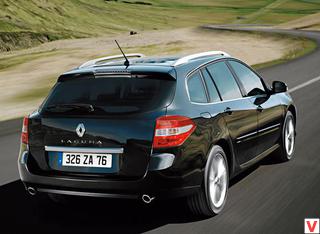
Improved interior insulation, trim materials, inserts of metal and natural wood appeared. As before, Laguna is equipped with a “keyless” control system - unlocking and locking doors, as well as starting the engine using an electronic smart card. The line of power units consists of gasoline engines of 1.6 and 2.0 liter capacity of 110 and 140 hp. respectively, as well as 1.5- and 2-liter turbo diesel. The vtop version is a 2-liter turbocharged engine delivering 170 hp, which is paired with a new 6-speed automatic with manual shift options. For other modifications, a 6-speed “mechanic” is also available. At the end of 2008, the Laguna model range was supplemented with a coupe version.
The history of this coupe originates from the concept of 2004 called Fluence - from there the main features of the tapering rear part are taken. Further, in the fall of 2007, at the Frankfurt Salon, he made his debut of the concept forerunner of a production car, which, by the way, had not changed much compared to the first. For the first time, Renault showed Laguna Coupe at the 61st Cannes Film Festival, but this was not the main car debut.
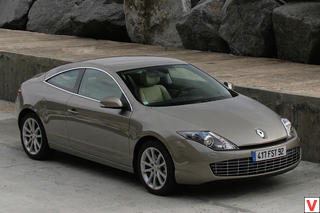
The official premiere took place at the Paris Motor Show in October 2008. The coupe version shared the platform with a sedan and a five-door hatchback Laguna. The dynamic silhouette of the model is characterized by natural elegance and combines the restraint and power typical of a large executive coupe.
The appearance of the car is a further development of the style of the Frankfurt concept. He has Laguna Coupe borrowed smooth contours of the body and sports roofline. Belonging to the family Laguna issued family front optics and a narrow grille slit. But the rear lights in Renault Laguna Coupe own, special - a pair of narrow LED lights.
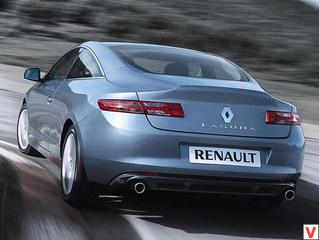
A small spoiler is integrated into the trunk lid, and a pair of chrome-plated exhaust pipes looks out of the rear bumper. Well, a few numbers: the length of the coupe is 4,640 mm, 1,830 mm wide and 1,400 mm high, with a wheelbase of 2,690 mm. The interior design reigns minimalism: leather interior, chrome inserts, dashboard, which brought only the most used functions. Careful elaboration of even the smallest details complements the overall elegance of the coupe. All the conditions for a comfortable and pleasant trip are created in the cabin: dual-zone climate control, heated seats, BOSE® audio system, etc.
For the coupe, there was also a pair of V 6 engines - one diesel and the other petrol. The diesel engine develops a power of 235 horsepower and a maximum torque of 450 Nm, while the gasoline working volume of 3.5 liters has 240 "horses" in reserve, but 330 Nm of torque. Two-liter engines are also expected: petrol power of 205 hp. and diesel 180 hp Both engines are turbocharged and borrowed from the Laguna GT. The engines are paired with a six-speed automatic or manual transmission. Following the Laguna GT, the coupe version received an Active Drive system - active rear wheel steering, which significantly improved handling.
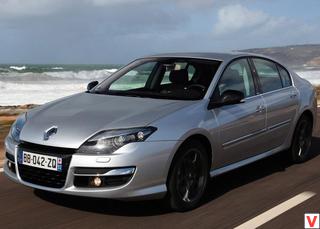
The rear wheels are controlled by electronics, which works in conjunction with the stabilization system ESP. When turning at speeds up to 60 km / h, they deviate in the opposite direction at an angle of 3.5 °, which makes it possible to reduce the turning circle and makes the coupe more maneuverable in urban environments. And at high speeds at the Renault Laguna Coupe, the rear wheels turn in the same direction as the front ones, and thus counteract the centrifugal force that is trying to push the rear part out of the turn. As a result, the car quickly turns into a turn. This made it possible to make the steering wheel sharper and increase the speed of cornering.
The driver and passengers of Laguna Coupe are provided with maximum safety, which is confirmed by a crash test from EURO NCAP, in which the car received the maximum 5 stars. An automatic parking brake, ESP and ABS systems with AFU allow you to drive with confidence. In the basic configuration Dynamique - six airbags, stabilization system, dual-zone climate control, leather seats, CD-audio system, parking sensors, heated front seats, light and rain sensors, bi-xenon headlights and alloy wheels.
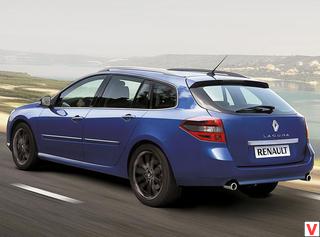
In 2010, Laguna was restyled. The manufacturer has updated the exterior and engine range. The main highlight of the refreshed Laguna design is the front part of the car with the grille and bumper extended downwards, in which niches for serial fog lamps have appeared. Complement changes in appearance, grown in size air intakes, chrome lining and new headlights.
The interior has received improved finishing materials. Technical changes were also made. Under the hood, there are a choice of 6 variants of 4-cylinder engines. They now meet strict but mandatory Euro-5 standards since 2011. Two gasoline engines. The base is the 2.0 16V 140 E85 eco2 with 140 hp.
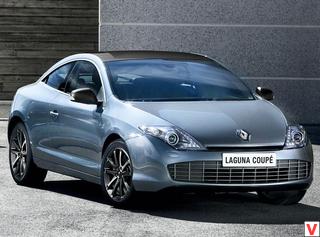
It can work not only on traditional gasoline, but also on bioethanol (E85). According to the manufacturer, its average consumption is 7.5 liters per 100 km, and with a station wagon - 7.6 liters. The second gasoline engine is called the TCe 170 Automatik.
170 hp turbocharged engine Available in top of the range Laguna GT and Initiale, which are equipped with a 6-speed automatic transmission from the factory. Consumption sedan and station wagon with this engine is 8.7 liters. Four diesel units.
The basic diesel engine is a 110 hp dCi 110 FAP eco2 engine. His appetite is limited to 4.7 liters per 100 km. The remaining three diesel engines have a volume of 2.0 liters. and equipped with maintenance-free chain for gas distribution mechanism. The dCi 150 FAP eco2 has 150 hp.
and spends an average of 5.2 liters. The dCi 175 FAP Automatik engine has 173 hp. and works in the Laguna GT and Initiale trim levels paired with a 6-speed automatic. In both cases, he spends an average of 6.3 liters. The most powerful diesel engine is a 2.0-liter unit for 178 hp, with a torque of 400 Nm. Its trade designation is dCi 180 FAP.
It is also available only in the Laguna GT and Initiale, and its average consumption is 5.7 liters. (Grandtour: 5.8 l.). Separate words are deserved by the 4Control system, which is included in the standard equipment of the Laguna GT, and for other modifications it is offered as an option. 4Control is a special set of devices that, in synchronization with the steering turn, turns not only the front wheels, but also the rear wheels.
They rotate only a few degrees in the opposite direction to the front, which can significantly reduce the turning radius of the car. Laguna Coupe restyled changes affected only in 2012. Changed the car is not much.
The exterior has been refreshed with new headlights with diode daylight and 17-inch wheels. In addition, new body colors have become available. In the cabin, too, things haven't changed much: the dashboard has a new stitching, the audio system and upholstery materials have been updated. In a number of power units, there are 3 petrol and 2 diesel engines, which are equipped with a six-speed "mechanics" or "automatic". Among the gasoline units - a two-liter engine producing 150 hp, a turbo engine with a volume of 2.0 liters (170 and 205 hp), as well as a “engine” of 240 hp. v6 volume of 3.0 liters.
The diesel engines for the Renault Laguna made M9R engines with three power options - 150, 175 and 180 hp, as well as a three-liter V6 240 hp engine. The car will receive a stop-start system (a 150-strong version with a diesel engine), which will allow saving by spending 13% less (4.5 liters per 100 km of run) fuel and emit 118 g / km CO2. The basic equipment Laguna Coupe includes bi-xenon headlights with a pivot element, 17-inch alloy wheels SARI Dark Metallic, electric front seats, driver's seat with memory, folding exterior mirrors with electric heating and memory, as well as the CARMINAT TomTom navigation system.
In addition, the car is equipped with an eight-speaker Bose audio system, a hands-free chip card, a Soft-Auto-Fast three-level climate control system, a cruise control, a multifunctional steering wheel and a rear parking sensor.
